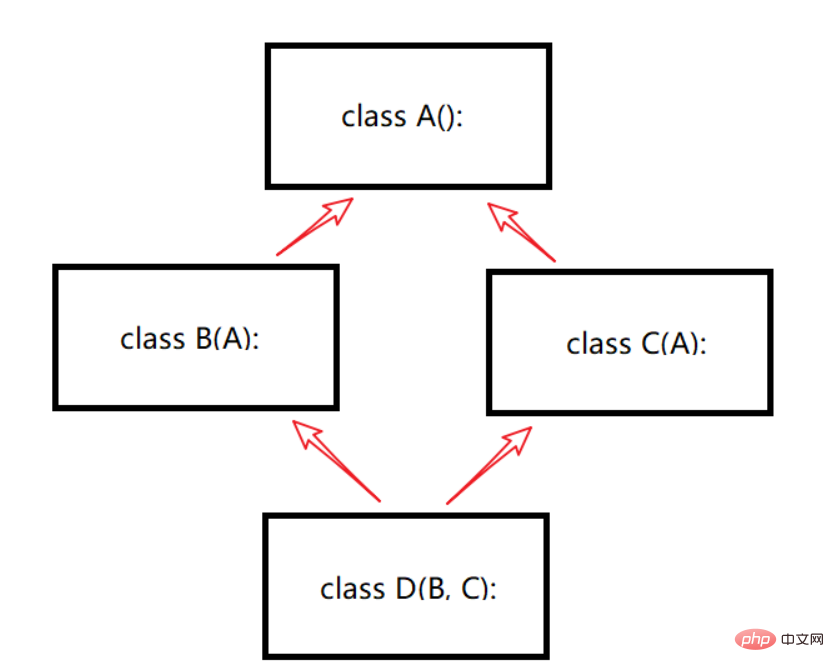Home > Article > Backend Development > Diamond inheritance in Python multiple inheritance
This article introduces the usage of diamond inheritance in Python multiple inheritance. I hope it will be helpful to friends who are learning Python!

Inheritance is an important method of object-oriented programming. Through inheritance, subclasses can extend the functions of parent classes. In python, a class can inherit from more than one parent class. This is called python's Multiple Inheritance (Multiple Inheritance).
Syntax
class SubclassName(BaseClass1, BaseClass2, BaseClass3, ...):
passRecommended learning: Python video tutorial
Inheritance at multiple levels When used together with multiple inheritance, complex inheritance relationships will appear, such as multiple inheritance.
Among them, diamond inheritance will appear. As shown below. 
In this structure, there are doubts about the calling order. Which of the following is the calling order?
Let’s answer this question.
Let’s take an example:
class A():
def __init__(self):
print('init A...')
print('end A...')
class B(A):
def __init__(self):
print('init B...')
A.__init__(self)
print('end B...')
class C(A):
def __init__(self):
print('init C...')
A.__init__(self)
print('end C...')
class D(B, C):
def __init__(self):
print('init D...')
B.__init__(self)
C.__init__(self)
print('end D...')
if __name__ == '__main__':
D()Output result
init D... init B... init A... end A... end B... init C... init A... end A... end C... end D...
From the output result, the calling sequence is: D->B->A-> ;C->A. It can be seen that B and C jointly inherit from A, and A is called twice. There is no need to call A twice.
Actually, the root causes of the above problems are all related to MRO. MRO (Method Resolution Order) is also called Method Resolution Order, which is mainly used to determine the resolution during multiple inheritance. Which class does the attribute come from? It uses an algorithm called C3. The basic idea is that uses breadth first and left to right on the premise of avoiding the same class being called multiple times. principles to find the required properties and methods.
So how to prevent a method in the top-level parent class from being called multiple times? Super() is needed at this time. Super is essentially a class that records MRO information internally. , since the C3 algorithm ensures that the same class will only be searched once, thus avoiding the method in the top-level parent class from being executed multiple times, the above code can be changed to:
class A():
def __init__(self):
print('init A...')
print('end A...')
class B(A):
def __init__(self):
print('init B...')
super(B, self).__init__()
print('end B...')
class C(A):
def __init__(self):
print('init C...')
super(C, self).__init__()
print('end C...')
class D(B, C):
def __init__(self):
print('init D...')
super(D, self).__init__()
print('end D...')
if __name__ == '__main__':
D()Output result:
init D... init B... init C... init A... end A... end C... end B... end D...
It can be seen that the calling sequence at this time is D->B->C->A. That is, the breadth-first traversal method is used.
Python classes are divided into two types, one is called classic class, and the other is called new style class. Both support multiple inheritance, but the order of inheritance is different.
There are two types of classes in Python 2.x: classic classes and new classes. Python3.x is full of new-style classes.
For more python related tutorials, please pay attention to the python tutorial column.
The above is the detailed content of Diamond inheritance in Python multiple inheritance. For more information, please follow other related articles on the PHP Chinese website!